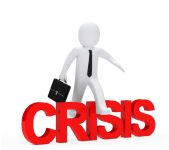In a perfect world, businesses run smoothly, markets remain stable, and teams work in harmony. But in reality?  Crises strike when you least expect them—a data breach, a PR disaster, a sudden financial hit, or even a global pandemic. What separates resilient organizations from failing ones is not whether a crisis occurs, but how they respond to it.
Crises strike when you least expect them—a data breach, a PR disaster, a sudden financial hit, or even a global pandemic. What separates resilient organizations from failing ones is not whether a crisis occurs, but how they respond to it.
Welcome to the world of crisis management, where quick thinking, calm leadership, and clear communication aren’t just preferred—they're non-negotiable.
Crises don’t follow schedules. They come unannounced and often with devastating speed. But here's the twist—not all crises are created equal:
They develop contingency plans, identify key risks, and regularly run mock drills. These aren't just checklists—they're playbooks of survival.
A Crisis Response Team isn’t formed during the storm—it’s built before. From CEOs to security heads to media spokespeople, roles are defined clearly.
In a crisis, communication is oxygen. Silence creates panic. A strong crisis communication strategy ensures timely, honest, and empathetic messaging to all stakeholders—employees, customers, media, and investors.
Crisis management isn't about avoiding the storm—it's about building a ship that can sail through it. In an age where the unexpected is the new normal, being prepared is power.
So next time the alarm bells ring, remember: Stay calm. Lead boldly. Communicate clearly. And never waste a crisis—it’s a classroom in disguise.
Welcome to the world of crisis management, where quick thinking, calm leadership, and clear communication aren’t just preferred—they're non-negotiable.
Crises Don’t Knock, They Break In
Crises don’t follow schedules. They come unannounced and often with devastating speed. But here's the twist—not all crises are created equal:
- Natural (floods, earthquakes)
- Operational (product recalls, system failures)
- Reputational (public backlash, leadership scandals)
- Financial (market crashes, fraud)
The Compass During Chaos: A Good Plan
Effective crisis management begins long before the crisis hits. It’s not just damage control—it’s damage prevention. Here's what resilient organizations do right: 1. Plan, Rehearse, Repeat
1. Plan, Rehearse, Repeat
They develop contingency plans, identify key risks, and regularly run mock drills. These aren't just checklists—they're playbooks of survival. 2. Empower the Right People
2. Empower the Right People
A Crisis Response Team isn’t formed during the storm—it’s built before. From CEOs to security heads to media spokespeople, roles are defined clearly. 3. Control the Narrative
3. Control the Narrative
In a crisis, communication is oxygen. Silence creates panic. A strong crisis communication strategy ensures timely, honest, and empathetic messaging to all stakeholders—employees, customers, media, and investors.Silver Linings Exist
While painful, crises often become catalysts for transformation. They:- Expose broken systems
- Encourage digital upgrades
- Drive innovation and transparency
- Strengthen leadership character
Final Thoughts: Courage Over Chaos
Crisis management isn't about avoiding the storm—it's about building a ship that can sail through it. In an age where the unexpected is the new normal, being prepared is power.
So next time the alarm bells ring, remember: Stay calm. Lead boldly. Communicate clearly. And never waste a crisis—it’s a classroom in disguise.

